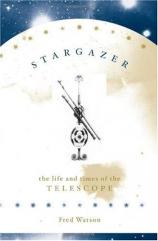Stargazer: The Life and Times of the Telescope
Review
Stargazer: The Life and Times of the Telescope
An optical telescope is basically a mirror for catching light. Once
this principle is understood, it follows that the bigger the
mirror, the more we can see, at greater distances with greater
accuracy. The only limitation is the human eye. But the history of
the telescope is not merely a history of perfecting bigger, better
mirrors. It is a surprisingly human, grounded saga of men
struggling not only with technology but also with each other ---
philosophically, politically, and financially.
Before the invention of the telescope, the universe had to be
invented. It was once believed that the night sky, so beloved of
astronomers and courting couples, was simply a flat backdrop for a
nightly drama played out by the stars. Space was a curtain. It took
a genius or two to map out the earth's place among the stars, and a
number of lesser known but no less brilliant men to figure out how
to see what was out there. The most recognized name in early
astronomy is Galileo, who was not the instrument's inventor. Fred
Watson --- astronomer, writer, and author of STARGAZER --- informs
us that no one person can claim that honor. Galileo was among the
very first to construct, use and refine the telescope and got the
pleasure of naming all sorts of things (he cleverly named the moons
of Jupiter for the Medici family, hoping to gain ducal favor
thereby).
Subsequent inventions have been improvements on the basic
telescope, adding more lenses and bigger tubes, up to the modern
era when we non-astronomers assume that things in the Hubble era
have gone about as far as they can go. There is a limit to the
number of good sighting places on earth --- the requirements are
height and low population density along with near perfect weather
conditions. And there is a theoretical limit to how big a lens can
be, though Watson recounts a project called OWL (Overwhelmingly
Large). "OWL was to be a telescope of no less than 100 metres
aperture with a mirror made up of hexagonal segments measuring 2.3
metres across --- a staggering 1600 of them…most of the
Universe --- literally --- would fall within its grasp." But OWL is
still on the drawing boards, with some scientists considering it a
"ULT --- Uselessly Large Telescope."
Watson's book never burdens the reader with too much technical
mass, and keeps the human angle always in focus. Most of the book
consists of dramatic, often humorous stories of various attempts to
make the heavens come to earth through the lens of the telescope.
The author's ability to put us ordinary earthbound folk in the big
picture is a significant contribution to the subject.
Stargazer: The Life and Times of the Telescope
- Publication Date: July 12, 2005
- Genres: Nonfiction
- Hardcover: 360 pages
- Publisher: Da Capo Press
- ISBN-10: 0306814323
- ISBN-13: 9780306814327




